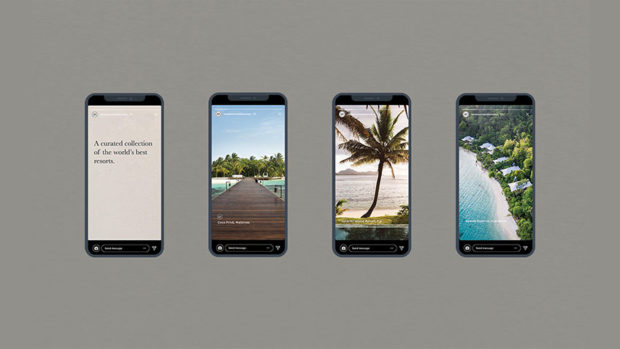Tips for private club marketing professionals to become a storyteller to drive engagement and sales into their clubs and resorts.
Think about the nature of human connections for a minute. We build friendships by relating with other people – by finding common ground, or interesting anecdotes that endear us to them. the fraternal culture of private clubs, in this instance, is our common thread.
And one of the most common ways we build these connections is through storytelling.
We can apply the same concept to how we tell the story of a particular brand. How would you translate a day in the life of your club to people online?
“Stories are deeply and fundamentally engaging to consumers, and because people can relate to stories, creating content with this in mind on your most important social platforms creates the basis for authentic conversations,” says Zack Bates, CEO at Private Club Marketing.
Considering that about 75% of people don’t trust traditional forms of marketing, and the fact that we’re exposed to thousands of marketing messages on a daily basis, you need to find a way to cut through the clutter in a meaningful way.
“People don’t buy what you do, they buy why you do it and how it makes them feel, and the measured results of visual storytelling to respond to these two reality checks is why we’ve seen a marketing shift across all industries, and more recently in golf,” says Bates.
A common misconception around the storyteller approach is that you need a massive budget to execute effectively. No matter how much money you’re working with, there are hundreds of ways to adopt storytelling in your marketing efforts.
Storytelling in club marketing
By using the storyteller approach in your club marketing strategy, you can relate valuable content without actually ‘selling’ your club (or membership) to guests. Rather, you’re showing them why they should choose you over your competitors in an engaging, authentic way.
According to Canada Post study, print media provides a boost in both engagement and recall. Consumers who see a print ad actually recall it 75 percent of the time. Meanwhile, among those who have been “exposed” to a digital ad online, a problematic metric known as “viewability” and one the advertising industry has yet to figure out — only 44 percent recall seeing the ad or even remember its contents.
In addition, there is the essential marketing issue of “engagement” — or driving audience interest, inspiration and action. Among those readers who have seen a print ad, 64 percent say they have been inspired to take action, a level often much better than the engagement inspired by digital ads. And while the cost per thousand views (CPM) for a print ad — given its smaller scale — can be higher than digital, the average return on advertising spend for magazine ads is considerably higher than for digital display.
When considering how to incorporate this strategy in your own marketing efforts, it’s important to note that your club doesn’t need to only have one set narrative. Rather, think about day-to-day activities or features as unique stories within themselves – magic moments that happen around your pool; your head chef explaining how to make a particular dish; some photos showing what you’re planting in your veggie garden this season – all of these can be packaged as a form of storytelling through your online channels.
Here are some important considerations to make in crafting your online narrative.
Target your key audience
Who are you trying to reach? You can’t be everything to everyone, so determine who your key audience is and build your strategy around that. Think about the types of members who come through your doors. What are some of their most common requests? What do they enjoy doing, and how does that tie into your club?
Determine your brand’s voice
How do you want to communicate with members and guests? Fun and quirky? Relaxed and conversational? Strictly professional? Think about the tone of voice that best suits your brand and stick with it. Your key audience may also affect this decision.
People don’t buy what you do, they buy why you do it and how it makes them feel, and the measured results of visual storytelling to respond to these two reality checks is why we’ve seen a marketing shift across all industries, and more recently in hospitality.
Think about your story
What interesting stories does your club have to share? Your property might be steeped in history, or you might be a leader in conservation and green practices.
But don’t only think about your club’s story – also consider your area and how you fit into that narrative. Do you get involved in your local community, for instance? Why not take a tour of your town, highlighting all the nearby attractions?
List all the benefits your club has to offer, and what values you share with your defined audience.
Tell your story in an engaging way
Images and video always trump text. Use high-quality imagery, and give some thought to what aspects of your narrative you can relay through video. And you don’t need a massive budget. So often, a smartphone with a good camera can help you create thoughtful and engaging content.
For example, go into the kitchen and conduct a quick video interview with your head chef, asking him why he’s so passionate about cooking. Take a slow video pan of the amazing views seen from your property and tie that into a story about why people should stay with you.
Or if budget allows, you could even consider making a short film, like the marketers at Marriott.
Create a content plan
Once you’ve given some thought to the information above, schedule a monthly content plan. Determine how often you should post the content ideas you’ve outlined and stick to it. Long gone are the days of having a Facebook page gather dust between annual updates.
Elicit user-generated content from your guests
For an online marketer or club owner, nothing is quite as satisfying as seeing guests getting involved with the club’s narrative in a positive way. It creates great social proof, and turns people into vocal ambassadors for your brand.
Take the lead and create a competition centered on your club and its story. For example, create a hashtag relevant to your brand and encourage people to submit their favorite photographs from their recent golf round or event, or even a recent golf trip.
Know how to get the most out of your social media channels
When posting a story on social media, remember that photos, videos and links get better engagement than text-only posts. Try using an interesting, high-quality photo to stand out together with a well-written post that takes the reader on a journey. Engage with your followers promptly, and remember to be consistent with the tone/voice you’ve chosen.
Good club storytellers online are moving away from the huge chunks of boring, standardized text and descriptions of amenities, towards the use of big, beautiful, bold images with captivating narratives and compelling bite-sized videos, more fitting to today’s multi-device, multi-channel universe.
Select which media channels you can commit to and then post as regularly as you can.
Using social media purely for self-promotion is a mistake that many clubs and brands make, but by using a storytelling approach for your efforts, you can make sure you get the right balance between creating interesting, engaging content that will promote your club.
In today’s day and age, potential members and guests (especially millennials) do not like to be sold to and will not want to follow your club if you are constantly bombarding their newsfeed with posts that say ‘Membership Special’. Instead, act as a digital concierge and share posts that these guests in the area would find useful.









No Comments